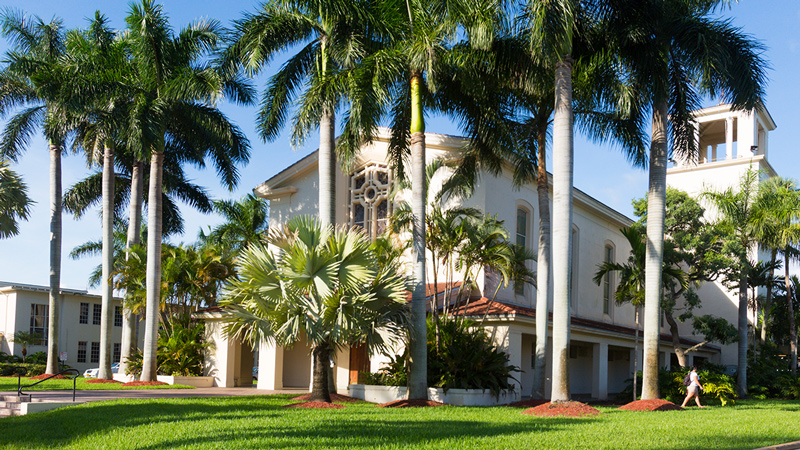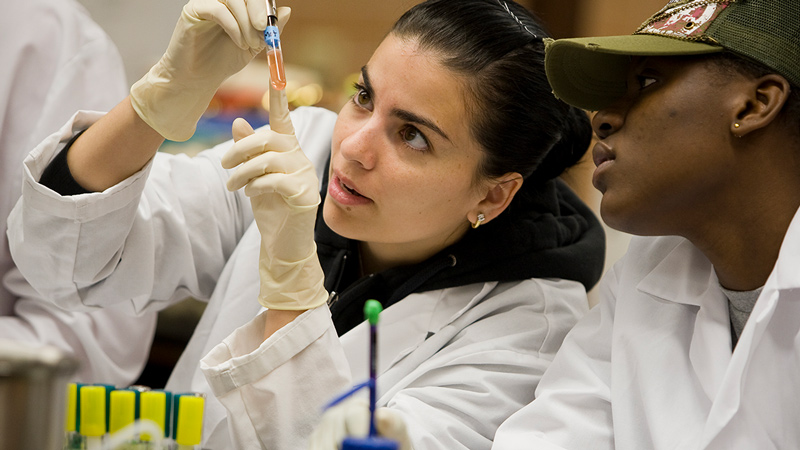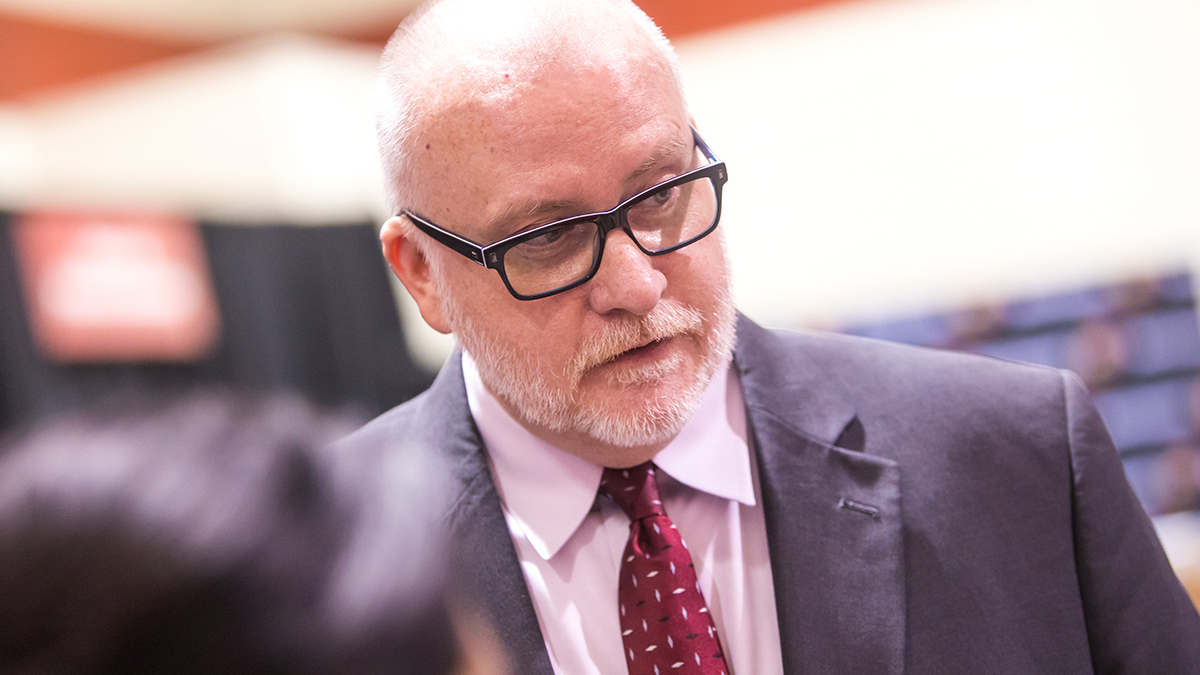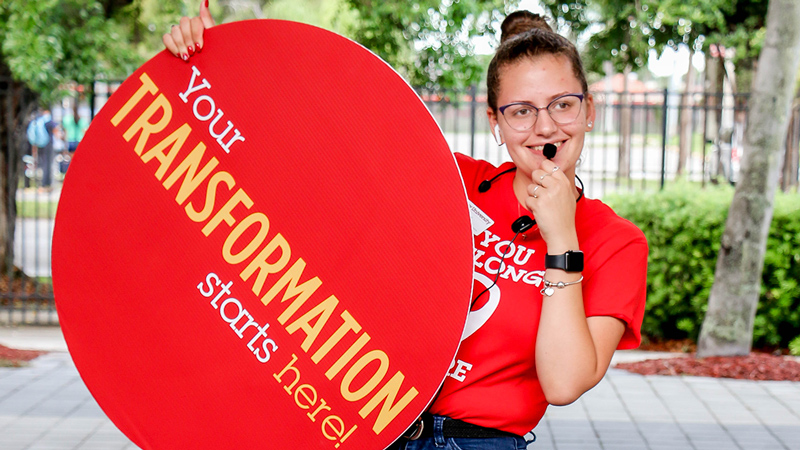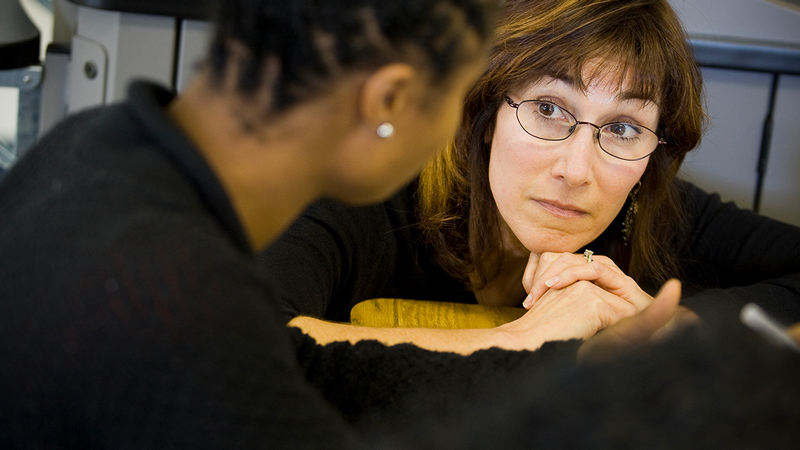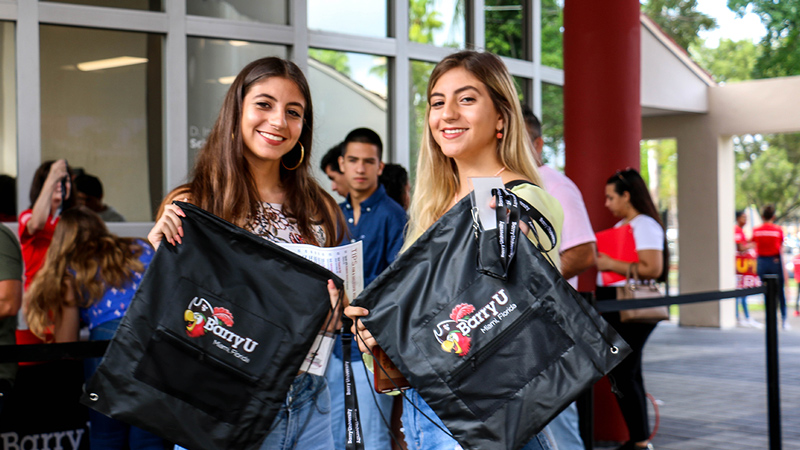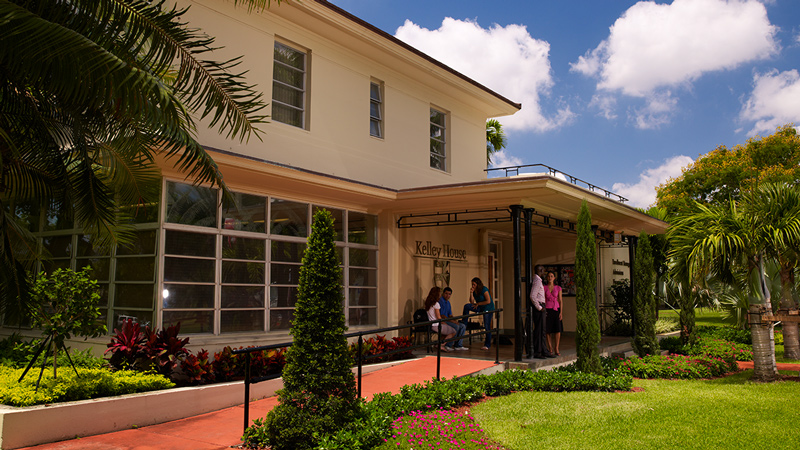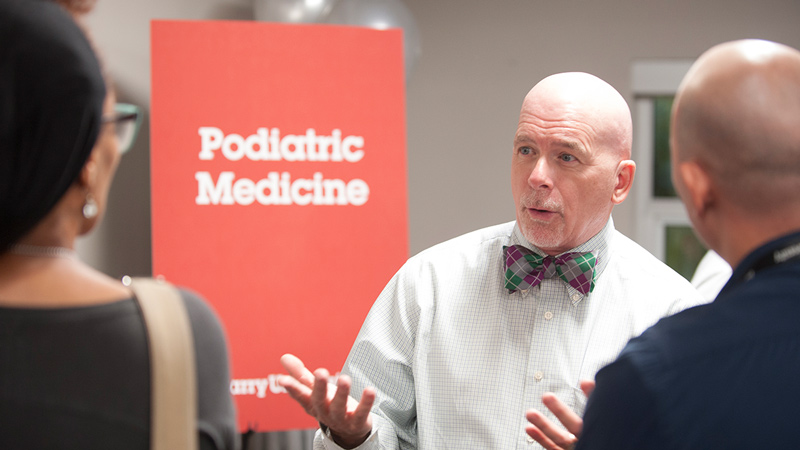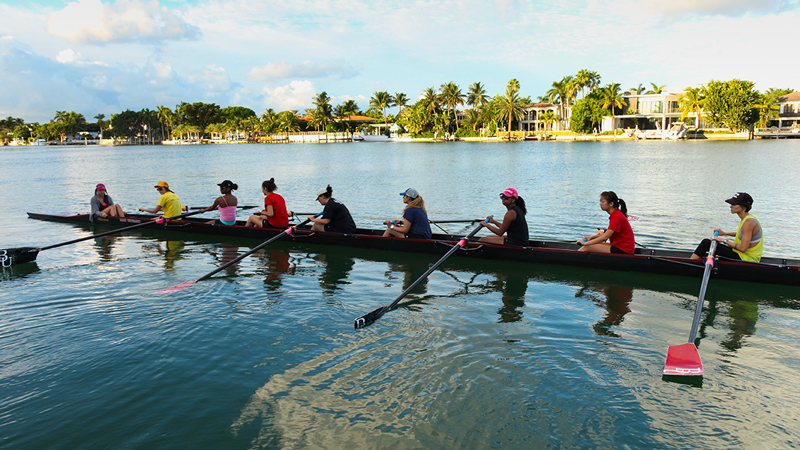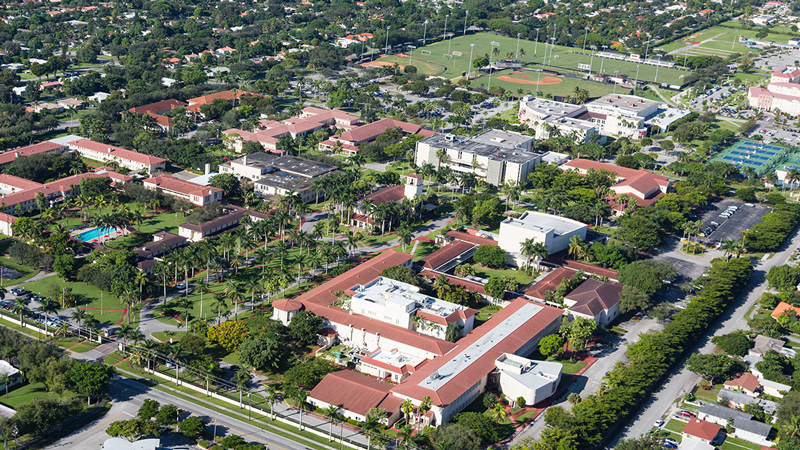Thus, in accordance with the Southern Association of Colleges and Schools Commission on Colleges (SACSCOC) Standard 8.1, “The institution identifies, evaluates, and publishes goals and outcomes for student achievement appropriate to the institution’s mission…,” Barry University has identified student achievement metrics, provided appropriate data, established thresholds of acceptability, and explained how each criteria relates to its mission. The student achievement measures identified by the University are:
- Retention of first time, full time students
- Graduation of first, time full time students
- Success in developmental courses (math and writing)
- National competency examinations
The Barry University mission statement states that we are a Catholic institution of higher education founded in 1940 by the Adrian Dominican Sisters. Grounded in the liberal arts tradition, Barry University is a scholarly community committed to the highest academic standards in undergraduate, graduate, and professional education. Each measure is in alignment with the University’s mission statement. The University strives to attain the highest student achievement outcomes possible.
The information on this site provides a representation of the accomplishment of our students in meeting these broad goals.
CURRENT FRESHMAN RETENTION & GRADUATION RATES


HISTORICAL FRESHMAN RETENTION & GRADUATION RATES
| SIX-YEAR GRADUATION RATES | |||||||
|---|---|---|---|---|---|---|---|
| COHORT YEAR | IPEDS COHORT | IPEDS: BU GRAD RATES | NATIONAL IPEDS BENCHMARK* | NSCH COHORT | NSCH COMPLETION AT BU | NSCH COMPLETION AT DIFFERENT INSTITUTION | NSCH NATIONAL BENCHMARK** |
| 2009 | 648 | 33% | 56% | 843 | 35% | 15% | 71% |
| 2010 | 625 | 31% | 55% | 741 | 37% | 17% | 74% |
| 2011 | 662 | 35% | 54% | 665 | 40% | 15% | 76% |
| 2012 | 622 | 36% | 55% | 658 | 42% | 15% | 76% |
| 2013 | 562 | 35% | 55% | 587 | 41% | 16% | 76% |
First-time, degree seeking students who started their postsecondary studies in the fall term of the cohort year. Source: National Student Clearinghouse (NSCH)
*National IPEDS benchmark includes all Four-Year, Private, Nonprofit, degree granting institutions in the US.
**National benchmark for Four-Year, Private, Nonprofit Institutions National Student Clearinghouse (NSCH)
Percentages may not add up to 100% due to rounding error.
| FIRST YEAR RETENTION RATES | ||||||
|---|---|---|---|---|---|---|
| COHORT YEAR | IPEDS COHORT | IPEDS: BU RETEN. RATES | NATIONAL IPEDS BENCHMARK** | NSCH COHORT | NSCH RETENTION AT BU | NATIONAL NSCH BENCHMARK* |
| 2014 | 459 | 65% | 75% | 714 | 67% | 74% |
| 2015 | 431 | 65% | 75% | 600 | 66% | 75% |
| 2016 | 479 | 61% | 75% | 565 | 61% | 74% |
| 2017 | 604 | 62% | 74% | 699 | 64% | 74% |
| 2018 | 639 | 65% | ** | *** | *** | *** |
First-time, all entering students (including non-degree and degree seeking students for the 2013 and 2014 cohorts; non-degree students not reported in 2015 cohort and beyond). Source: National Student Clearinghouse
*National IPEDS benchmark includes all Four-Year, Private, Nonprofit, degree granting institutions in the US.
**National benchmark for Four-Year, Private, Nonprofit Institutions. Source: National Student Clearinghouse (NSCH)
**Data not yet available
Percentages may not add up to 100% due to rounding error.
RETENTION & GRADUATION RATES: INDEX OF FINANCIAL NEED
| UNDERGRADUATE FIRST TIME, FULL TIME RETENTION RATES: INDEX OF FINANCIAL NEED | |||
|---|---|---|---|
| RETENTION RATE (NO. OF STUDENTS) | |||
| FALL TERM/YEAR | PELL GRANT RECEIPIENTS | RECIPIENTS OF DIRECT SUBSIDIZED LOAN WITHOUT PELL GRANT | RECEIVED NEITHER PELL GRANT NOR DIRECT SUBSIDIZED LOAN |
| Fall 2018 | 67% (442) | 54%(76) | 63%(121) |
| Fall 2017 | 62%(403) | 57%(58) | 63%(143) |
| Fall 2016 | 56%(254) | 57%(88) | 75%(137) |
| Fall 2015 | 68%(250) | 67%(46) | 60%(135) |
| Fall 2014 | 65%(252) | 60%(68) | 67%(139) |
| UNDERGRADUATE FIRST TIME, FULL TIME SIX YEAR GRADUATION RATES: INDEX OF FINANCIAL NEED | |||
|---|---|---|---|
| RETENTION RATE (NO. OF STUDENTS) | |||
| FALL TERM/YEAR | PELL GRANT RECEIPIENTS | RECIPIENTS OF DIRECT SUBSIDIZED LOAN WITHOUT PELL GRANT | RECEIVED NEITHER PELL GRANT NOR DIRECT SUBSIDIZED LOAN |
| Fall 2013 | 32%(352) | 0%(91) | 42%(119) |
| Fall 2012 | 30%(390) | 33%(99) | 57%(133) |
| Fall 2011 | 33%(375) | 29%(117) | 44%(170) |
| Fall 2010 | 25%(338) | 28%(95) | 41%(192) |
| Fall 2009 | 31%(407) | 26%(92) | 44%(149) |
DEVELOPMENTAL COURSEWORK COMPLETION
| PASS RATES OF UNDERGRADUATE STUDENTS IN DEVELOPMENTAL AND FIRST COLLEGE LEVEL MATH COURSES | ||||
|---|---|---|---|---|
| YEAR* | % SUCCESSFULLY COMPLETED DEVELOPMENTAL MATH AND SUBSEQUENTLY REGISTERED FOR A COLLEGE LEVEL MATH | % SUCCESSFULLY COMPLETED DEVELOPMENTAL MATH AND DID NOT REGISTER IN A COLLEGE LEVEL MATH | TOTAL % SUCCESSFULLY COMPLETED DEVELOPMENTAL MATH | % SUCCESSFULLY COMPLETED MAT 107, 108, 109 OR 152 (FIRST COLLEGE LEVEL COURSES) |
| 2017 | 65% | 22% | 87% | 93% |
| 2016 | 68% | 17% | 85% | 94% |
| 2015 | 63% | 20% | 83% | 91% |
| 2014 | 66% | 19% | 85% | 88% |
| 2013 | 60% | 21% | 81% | 86% |
| PASS RATES OF UNDERGRADUATE STUDENTS IN DEVELOPMENTAL (ENG 095) AND FIRST COLLEGE LEVEL ENGLISH WRITING (ENG 111) COURSES | ||||
| YEAR* | % SUCCESSFULLY COMPLETED ENG 095 AND SUBSEQUENTLY REGISTERED FOR ENG 111 | % SUCCESSFULLY COMPLETED ENG 095 AND DID NOT REGISTER FOR ENG 111 | TOTAL % SUCCESSFULLY COMPLETED ENG 095 | % SUCCESSFULLY COMPLETED ENG 111 (FIRST COLLEGE LEVEL WRITING COURSE) |
| 2017 | 72% | 16% | 88% | 86% |
| 2016 | 59% | 34% | 93% | 93% |
| 2015 | 76% | 9% | 85% | 89% |
| 2014 | 64% | 15% | 79% | 86% |
| 2013 | 59% | 18% | 77% | 90% |
*Includes Summer II, Fall, Spring, Summer I terms
NATIONAL COMPETENCY EXAMINATIONS AND GRADUATE PLACEMENTS
NURSING & HEALTH SCIENCES
In the College of Nursing and Health Sciences, the undergraduate and master’s programs in nursing are accredited by the Commission on Collegiate Nursing Education. The undergraduate nursing program is approved by the Florida Board of Nursing. The Occupational therapy Program is accredited by the Accreditation Council for Occupational Therapy Education. The Cardiovascular Perfusion Program is accredited by the Commission on Accreditation of Allied Health Education Programs (CAAHEP). The Anesthesiology Program is accredited by the Council on Accreditation of Nurse Anesthesia Educational Programs.
The Bachelor of Science in Clinical Biology with a Histotechnology specialization, Post-Baccalaureate Certificate in Histotechnology and Master of Science in Clinical Biology with a Histotechnology specialization are approved by the Florida Department of Health, Board of Clinical Laboratory Personnel, and accredited by the National Accrediting Agency for Clinical Laboratory Sciences (NAACLS). The Master of Science in Medical Biotechnology has been recognized as a Professional Science Master's (PSM) Program by the Council of Graduate Schools.
The National Council Licensure Examination (NCLEX) Outcomes
| YEAR | NO. OF STUDENTS TAKING NCLEX | FIRST TIME PASS RATE |
|---|---|---|
| 2018 | 15 | 86.66% |
| 2017 | 99 | 88.88% |
| 2016 | 123 | 84.55% |
| 2015 | 149 | 83.22% |
Physician Assistant National Certification Exam (PANCE) Outcomes
| CLASS | NUMBER OF FIRST-TIME TAKERS | PROGRAM FIRST-TIME TAKER PASS RATE | NATIONAL FIRST-TIME TAKER PASS RATE FOR THE CLASS GRADUATION YEAR |
|---|---|---|---|
| 2018 | 95 | 95% | 98% |
| 2017 | 100 | 93% | 97% |
| 2016 | 99 | 95% | 96% |
| 2015 | 95 | 95% | 96% |
| 2014 | 100 | 90% | 95% |
| 2013 | 89 | 91% | 94% |
Graduates of the Barry University Physician Assistant Program are passing the Physician Assistant National Certifying Examination (PANCE) at a rate that is comparable to the average rate for all physician assistant programs. For more information, visit https://www.barry.edu/physician-assistant.
Post-Baccalaureate DNP in Anesthesiology National Certification Examination (NCE) Outcomes
| CLASS | NUMBER OF GRADUATING STUDENTS | PROGRAM FIRST-TIME TAKER PASS RATE | OVERALL PASS RATE |
|---|---|---|---|
| 2019 | 74 | 89% | 97% |
| 2018 | 49 | 86% | 100% |
| 2017 | 61 | 92% | 100% |
| 2016 | 54 | 94% | 100% |
| 2015 | 50 | 90% | 100% |
| 2014 | 60 | 88% | 100% |
| 2013 | 73 | 95% | 100% |
All graduates gained employment within six (6) months of graduation.
Occupational Therapy National Certification Exam (NBCOT) Outcomes
| CLASS | NUMBER OF TAKERS | PASS RATE |
|---|---|---|
| 2018 | 39 | 97% |
| 2017 | 23 | 91% |
| 2016 | 35 | 100% |
| 2015 | 35 | 97% |
Retention Rate 2018: 98%; Graduation Rate: 99%.
LAW
Barry University Dwayne O. Andreas School of Law is approved by the Council of the Section of Legal Education and Admissions to the Bar of the American Bar Association.
Bar Passage Rates (February and July)
| EXAM YEAR | BARRY UNIVERSITY PASS RATE | FLORIDA PASS RATE |
|---|---|---|
| 2019 | 51% | 66% |
| 2018 | 43% | 63% |
| 2017 | 55% | 65% |
| 2016 | 43% | 63% |
| 2015 | 50% | 68% |
| 2014 | 62% | 72% |
| 2013 | 79% | 78% |
Employment Summary for 2018 Graduates
| EMPLOYMENT STATUS | |
|---|---|
| Employed - Bar Passage Required | 48% |
| Employed - J.D. Advantage | 22% |
| Employed - Professional Position | 12% |
| Employed - Non-Professional Position | 5% |
| Employed - Law School/University Founded | 1% |
| Pursuing Graduate Degree Full Time | 1% |
| Unemployed - Not Seeking | 1% |
| Unemployed - Seeking | 7% |
| Employment Status Unknown | 5% |
Employment Type
| EMPLOYMENT TYPE | |
|---|---|
| Law Firms | |
| Solo | 3% |
| 2 - 10 | 27% |
| 11 - 25 | 4% |
| 26 - 50 | 2% |
| 51 - 100 | 2% |
| 101 - 250 | 5% |
| 251 - 500 | 4% |
| 501 + | 1% |
| Unknown Size | 0% |
| Business & Industry | 25% |
| Government | 19% |
| Pub. Int. | 3% |
| Clerkships - State & Local | 1% |
| Education | 3% |
Graduates of the Barry University School of Law are passing the American Bar Association Bar Examination at a rate that is fairly comparable to the average rate for all law schools in the State of Florida. The Law School responded to the dip in passage rates in 2014 by increasing bar examination preparation for all current students.
PODIATRIC MEDICINE
There are many reasons to pursue a career as a podiatric physician. It is a medical/surgical career that is both challenging and rewarding. With the aging population and the global diabetes epidemic sweeping through the United States there will be an increased demand for high quality podiatric physicians in the future. In fact, the Bureau of Labor Statistics projects a 23% increase in positions for podiatric physicians by 2022. Barry University's Podiatric Medicine program is accredited by the Council on Podiatric Medical Education and the Commission on Colleges of the Southern Association of Colleges and Schools
Council, Podiatric Medical Education Outcome Data, September 1, 2019
| Part 1 APMLE Pass Rate (2017-2019, first-time takers only) | 79% |
| Part 2 APMLE Written Pass Rate (2017-2019, first-time takers only) | 92% |
| Part 2 APMLE CSPE Pass Rate (2017-2019, first-time takers only) | 86% |
| Four-year Graduation Rate (2017-2019 average) | 87% |
| Residency Placement Rate (2017-2019 average) | 99% |
BUSINESS
Barry University’s Andreas School of Business is accredited by AACSB International—The Association to Advance Collegiate Schools of Business (AACSB). Only about a third of all business schools in the United States are accredited by AACSB, the world's premier accrediting agency for bachelor's and graduate degree programs in business administration. Barry University is now the sole AACSB-accredited University in South Florida where the primary responsibility of the entire faculty is teaching. In addition, Barry is the only AACSB-accredited Catholic university in Florida and in all the southeastern states east of New Orleans.
Undergraduate Students Employment, 2017-18 Graduates
| Seeking Employment | 61% |
| Company Sponsored/Already Employed | 6% |
| Continuing Education | 19% |
| Starting Own Business | 5% |
| No Employment Information Available | 8% |
| Acceptance of Job Offers of Students Seeking Employment | 58% |
Source: AACSB 2017-18 BSQ Report
Salary Compensation for Undergraduate Students Accepting Employment, 2017-18 Graduates
| Base Salary - Mean | $54,571 |
| Base Salary – Median | $50,000 |
| Base Salary – Low | $12,000 |
| Base Salary – High | $100,000 |
Source: AACSB 2017-18 BSQ Report
Graduate Students Employment, 2017-18 Graduates
| Seeking Employment | 53% |
| Company Sponsored/Already Employed | 13% |
| Continuing Education | 11% |
| Starting Own Business | 4% |
| No Employment Information Available | 18% |
| Acceptance of Job Offers of Students Seeking Employment | 50% |
Source: AACSB 2017-18 BSQ Report
| Base Salary - Mean | $53,333 |
| Base Salary – Median | $45,000 |
| Base Salary – Low | $40,000 |
| Base Salary – High | $75,000 |
Source: AACSB 2017-18 BSQ Report
EDUCATION
Title II of the Higher Education Act (HEA) requires an annual report on the quality of teacher preparation. Institutions of higher education (IHE) that conduct teacher preparation programs enrolling students who receive federal assistance under the Title IV of the HEA fall under this mandate. A teacher preparation program is a state-approved course of study, the completion of which signifies that an enrollee has met all the state's educational and/or training requirements for initial certification or licensure to teach in the state's elementary or secondary schools.
SOCIAL WORK
Barry University's Social Work programs are accredited by the Council on Social Work Education. All Council on Social Work Education programs measure and report student learning outcomes. Students are assessed on their mastery of the competencies that comprise the accreditation standards of the Council on Social Work Education. These competencies are dimensions of social work practice that all social workers are expected to master during their professional training. A measurement benchmark is set by the social work programs for each competency. An assessment score at or above that benchmark is considered by the program to represent mastery of that particular competency.
FLORIDA EMPLOYMENT & EARNINGS INFORMATION
The employment rate within Florida for Barry University graduates with an undergraduate degree is higher than the average rate for graduates from other independent colleges and universities in Florida and comparable to the average employment rate from Florida public universities. The average salary for Barry University graduates with undergraduate degrees is higher than the average salary for graduates from independent and public universities.
2017-2018 Bachelor’s Degree Graduates
| UNIVERSITY | NUMBER OF GRADUATES | % EMPLOYED IN FLORIDA | MEAN EARNINGS | MEDIAN EARNINGS |
|---|---|---|---|---|
| Barry University | 655 | 67% | $56,220 | $48,664 |
| Average for 30 ICUF* schools | 573 | 51% | $37,828 | $34,356 |
| Average for 12 Florida public universities | 5,375 | 64% | $42,392 | N/A |
*Independent Colleges and Universities of Florida.
The Florida Education and Training Placement Information Program (FETPIP) is a data collection and consumer reporting system established by Florida statute. The purpose of FETPIP is to track students who have graduated, exited, or completed an educational or training program within the State of Florida. Among other services, the FETPIP tracking system reports on within-state employment of students following graduation from a college or university in the state. For more information about FETPIP visit: http://www.fldoe.org/accountability/fl-edu-training-placement-info-program/.
